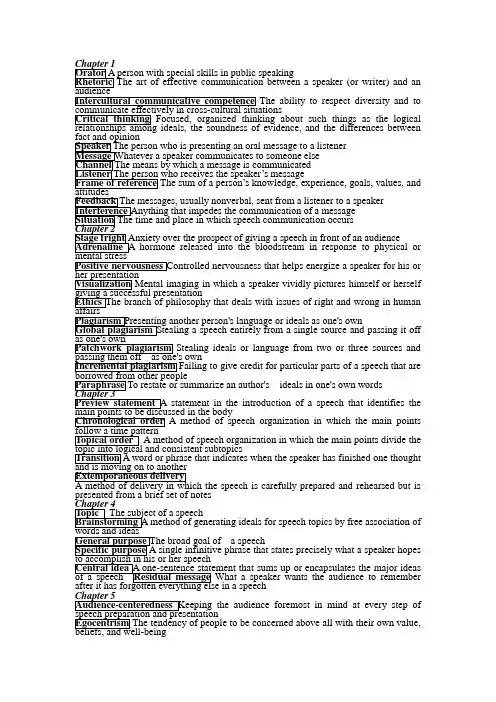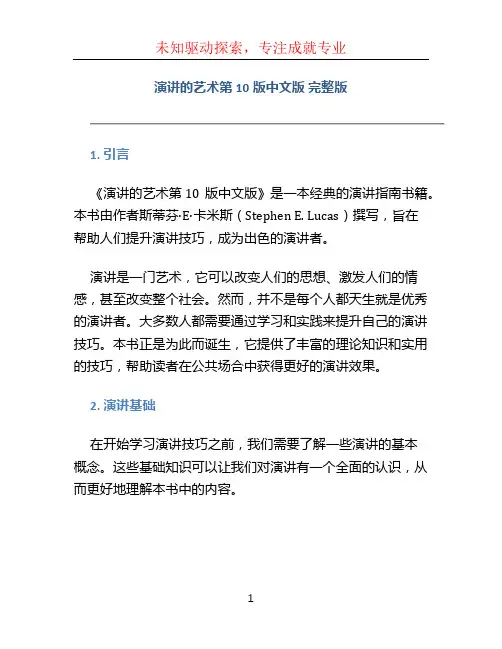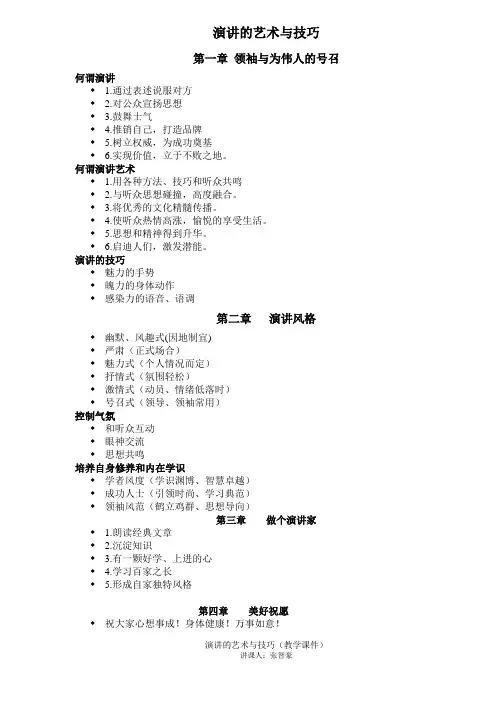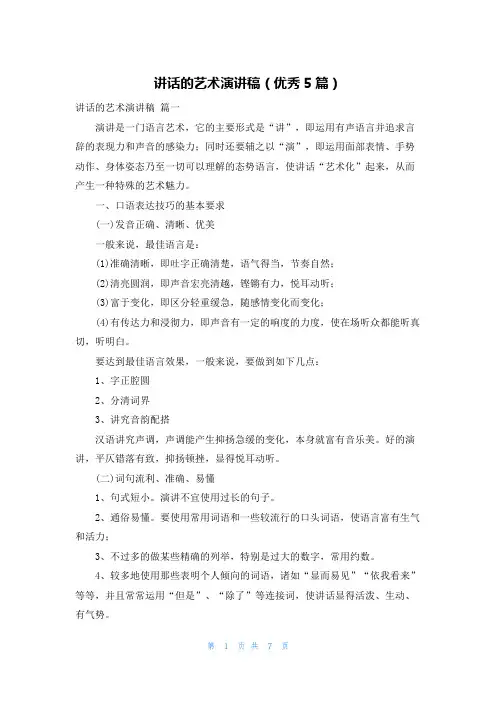2019-演讲的艺术-实用word文档 (7页)
演讲的艺术

The art of effective communication between a speaker (or writer) and anThe ability to respect diversity and toFocused, organized thinking about such things as the logicalideals, the soundness of evidence, and the differences between’s messageThe sum of a person’s knowledge, experience, goals, values, andhormone released into the bloodstream in response to physical orMental imaging in which a speaker vividly pictures himself or herselfStealing ideals or language from two or three sources andFailing to give credit for particular parts of a speech that areTo restate or summarize an author's ideals in one's own wordsstatement in the introduction of a speech that identifies theA method of speech organization in which the main pointsA method of speech organization in which the main points divide theA word or phrase that indicates when the speaker has finished one thoughtpresented from a brief set of notesa speechWhat a speaker wants the audience to rememberthe audience foremost in mind at every step ofThe tendency of people to be concerned above all with their own value,Audience characteristics such as age, gender, education,Questions that require responses at fixed intervals along a scale ofthat allow respondents to answer however theymaterials used to support a speaker's ideas. The threeA story, narrative, or anecdote developed at some length toa speech together in a particular way to achieve aThe major points developed in the body of a speech. Most speechesmethod of speech organization in which the main pointsmethod of speech organization in which the main points follow amethod of speech organization in which the first mainof a problem and the second main point presents aA method of speech organization in which the main points divide theA word or phrase that indicates when a speaker has finished one thoughtstatement in the body of the speech that summarizes theA very brief statement that indicates where a speaker is in the speech or thatA question that the audience answers mentally rather than outstatement in the introduction of a speech that identifies the课后练习Chapter 4Topic :Studying abroadGeneral Purpose:To persuadeSpecific Purpose:To persuade the audience to study abroad will enhance your personal development,academic development,and career development.Central Idea:Main points: I. You should study abroad because it will enhance your personal development.II. You should study abroad because it will enhance your academic developmentIII. You should study abroad because it will enhance your career development.Topic : Events in triathlonGeneral purpose: To informSpecific purpose: To inform the audience of the three events in triathlon : swimming, cycling and running.Central Idea:Main points:The first event in triathlon is swimmingThe second event in triathlon is cycling.The third event in triathlon is running.I. The first major cause of airplane crashes is pilot error.II. The second major cause of airplane crashes is weather. Topical OrderIII. The third major cause of airplane crashes is mechanical failure.I. The peak of Mount Kilimanjaro has an arctic climate with snow,ice,,and violent winds.II. The middle of Mount Kilimanjaro has a rain forest climate with lush vegetation and diverse animal species.III. The base of Mount Kilimanjaro has a bushland climate with pastures and farming communities. Spatial OrderI. The Chinese film industry began in the early 20th century.II. The first golden period of Chinese cinema occurred during the 1930s.III. The second golden period occurred in the years after World War II.IV. The Chinese film industry was scaled back during the 1960s and 1970s.V. Today Chinese films are in another golden period of international acclaim.Chronological Order。
演讲的艺术课件

怎样写好演讲稿
C、听众没有了兴趣,怎么办
不可直言或咒骂观众的素质,而应以 紧扣主题的小故事或笑话等引起大家 的注意
D听众起哄怎么办
不要惊慌害怕走下台。
应该分析起哄原因:如是因 自己的口误所致,应真诚道歉。 如是有意捣乱,可置之不理让 其自讨没趣,或者运用自己的 智慧使其羞愧得无地自容。
(四)、如何写好演讲稿
《让青春年华承担责任》
(1)、主题 A、要积极、正确,不要唱反调 B、主题要单一,要说透说充分,
不要面面俱到
C、要符合要求,要有现实意义和 教育意义
(2)、选材
(3)、语言
写演讲稿运用好语言很重要。演讲者能恰到好处地运 用有声语言也就掌握了听众。演讲的语言应达到如下标 准:
A 要口语化 B 要生动感人 C 发挥语言的音乐性 要使语言的声音美充
B 材料不同:演讲有很大的现实性、时代 性,朗诵具有超越性
C 舞台效果不同:演讲讲究激情,朗诵追 求意境
(三)演讲的应变 及处理的几个大忌
A、演讲“卡壳”了,怎么 办
a、不可停顿太久 b、不可重新回读 c、不可拿出稿件照读 d、不要冲下台放弃
B、演讲失误,怎么办
不可置之不理,应向听众交代
分体现在语言的运用上,声调要和谐,节 奏要鲜明,还可以使用一些排比句,增强 所势。 D 用词要准确、朴素 用词的准确
本周周记题目
《让青春年华承担责任》
演讲的艺术

10% 读到的 20% 听到的 30% 看到的 50% 看到和听到的
演讲技巧——形体
演讲中要避免的
举止和动作
自鸣得意型 指挥动作,手舞足蹈
自恋自爱型 调整领带,整理头发
自说自话型 白日梦话,来回溜达
没精打采型 依靠式,懒洋洋式。手放在裤袋内摇动
胆怯紧张型 紧张的小动作,磨光台面式,见不得光式,裸体
回应问题可能是你显示的最重要的技巧。你的回应可能成为 听众是否被你的内容所折服的决定因素。
出于人的本性,我们往往会不由自主地立即做出反应,并解 答问题。但是演讲者应该采取的最有效行动却是先略作停顿 ,然后再以一种较有策略的饭食加以回答。停顿(PAUSE) 这一简单的英文单词能帮助你记住,在听众提出问题时应该 怎么办。
1. 演讲前熟悉和检查器材的操作和性能 2. 检查各作为的可视度 3. 先把胶片放好后在打开投影仪 4. 避免身体挡住屏幕或示范物 5. 避免对着屏幕、活动板说话或边写边说 6. 查问听众是否看得清楚 7. 不用时和解答问题前关掉机器 8. 用投影仪时可用纸掩盖未说明的部分 9. 可利用笔或指示物指向胶片中要说明的部分 10. 可以在胶片上把重点框起来 11. 可以利用空白胶片图解意思 12. 每一个重点将结过后,使用新的一页空白纸 13. 各种器材可以相互使用 14. 有些器材使用起来会花费时间
.........................................
.........................................
..........................................
..........................................
《演讲的艺术第10版中文版》完整版

演讲的艺术第10版中文版完整版1. 引言《演讲的艺术第10版中文版》是一本经典的演讲指南书籍。
本书由作者斯蒂芬·E·卡米斯(Stephen E. Lucas)撰写,旨在帮助人们提升演讲技巧,成为出色的演讲者。
演讲是一门艺术,它可以改变人们的思想、激发人们的情感,甚至改变整个社会。
然而,并不是每个人都天生就是优秀的演讲者。
大多数人都需要通过学习和实践来提升自己的演讲技巧。
本书正是为此而诞生,它提供了丰富的理论知识和实用的技巧,帮助读者在公共场合中获得更好的演讲效果。
2. 演讲基础在开始学习演讲技巧之前,我们需要了解一些演讲的基本概念。
这些基础知识可以让我们对演讲有一个全面的认识,从而更好地理解本书中的内容。
2.1 演讲的定义演讲是一种口头表达方式,通过语言和肢体来传递信息、观点和情感。
演讲通常在公共场合进行,旨在影响听众的思想和行为。
2.2 演讲的目的演讲的目的可以分为四类:说服、教育、娱乐和鼓舞。
不同的演讲目的需要采用不同的演讲策略和技巧。
2.3 演讲的要素演讲由三个要素组成:演讲者、听众和演讲内容。
了解这些要素之间的关系可以帮助我们更好地设计和传达演讲。
3. 演讲技巧本书围绕演讲技巧提供了详尽的指导和实践建议。
以下是一些重要的演讲技巧:3.1 演讲准备在进行任何演讲之前,准备工作至关重要。
这包括确定演讲目的、收集和整理演讲材料、设计演讲结构等。
演讲准备阶段的工作对于最终的演讲效果有着重要的影响。
3.2 演讲交流演讲是一个交流过程,而不仅仅是信息的传递。
在演讲中,演讲者需要与听众建立有效的沟通,例如通过使用肢体语言、眼神接触、声音控制等。
3.3 演讲技巧本书介绍了许多实用的演讲技巧,如声音和语速的控制、演讲稿的运用、幽默和故事的运用等。
这些技巧可以帮助演讲者更好地引起听众的兴趣和共鸣。
3.4 演讲练习演讲技巧的提升需要不断的练习和反思。
本书提供了一些演讲练习的方法和建议,帮助读者不断提升自己的演讲技能。
演讲的艺术与技巧(word版)

演讲的艺术与技巧
第一章领袖与为伟人的号召
何谓演讲
♦ 1.通过表述说服对方
♦ 2.对公众宣扬思想
♦ 3.鼓舞士气
♦ 4.推销自己,打造品牌
♦ 5.树立权威,为成功奠基
♦ 6.实现价值,立于不败之地。
何谓演讲艺术
♦ 1.用各种方法、技巧和听众共鸣
♦ 2.与听众思想碰撞,高度融合。
♦ 3.将优秀的文化精髓传播。
♦ 4.使听众热情高涨,愉悦的享受生活。
♦ 5.思想和精神得到升华。
♦ 6.启迪人们,激发潜能。
演讲的技巧
♦魅力的手势
♦魄力的身体动作
♦感染力的语音、语调
第二章演讲风格♦幽默、风趣式(因地制宜)
♦严肃(正式场合)
♦魅力式(个人情况而定)
♦抒情式(氛围轻松)
♦激情式(动员、情绪低落时)
♦号召式(领导、领袖常用)
控制气氛
♦和听众互动
♦眼神交流
♦思想共鸣
培养自身修养和内在学识
♦学者风度(学识渊博、智慧卓越)
♦成功人士(引领时尚、学习典范)
♦领袖风范(鹤立鸡群、思想导向)
第三章做个演讲家♦ 1.朗读经典文章
♦ 2.沉淀知识
♦ 3.有一颗好学、上进的心
♦ 4.学习百家之长
♦ 5.形成自家独特风格
第四章美好祝愿♦祝大家心想事成!身体健康!万事如意!。
讲话的艺术演讲稿(优秀5篇)

讲话的艺术演讲稿(优秀5篇)讲话的艺术演讲稿篇一演讲是一门语言艺术,它的主要形式是“讲”,即运用有声语言并追求言辞的表现力和声音的感染力;同时还要辅之以“演”,即运用面部表情、手势动作、身体姿态乃至一切可以理解的态势语言,使讲话“艺术化”起来,从而产生一种特殊的艺术魅力。
一、口语表达技巧的基本要求(一)发音正确、清晰、优美一般来说,最佳语言是:(1)准确清晰,即吐字正确清楚,语气得当,节奏自然;(2)清亮圆润,即声音宏亮清越,铿锵有力,悦耳动听;(3)富于变化,即区分轻重缓急,随感情变化而变化;(4)有传达力和浸彻力,即声音有一定的响度的力度,使在场听众都能听真切,听明白。
要达到最佳语言效果,一般来说,要做到如下几点:1、字正腔圆2、分清词界3、讲究音韵配搭汉语讲究声调,声调能产生抑扬急缓的变化,本身就富有音乐美。
好的演讲,平仄错落有致,抑扬顿挫,显得悦耳动听。
(二)词句流利、准确、易懂1、句式短小。
演讲不宜使用过长的句子。
2、通俗易懂。
要使用常用词语和一些较流行的口头词语,使语言富有生气和活力;3、不过多的做某些精确的列举,特别是过大的数字,常用约数。
4、较多地使用那些表明个人倾向的词语,诸如“显而易见”“依我看来”等等,并且常常运用“但是”、“除了”等连接词,使讲话显得活泼、生动、有气势。
(三)语调贴切、自然、动情一般来讲,表达坚定、果敢、豪迈、愤怒的思想感情,语气急骤,声音较重;表达幸福、温暖、体贴、欣慰的思想感情,语气舒缓,声音较轻;表示优雅、庄重、满足,语调前后尽弱中间强。
语调的选择和运用,必须切合思想内容,符合语言环境,考虑现场效果。
语调贴切、自然正是演讲者思想感情在语言上的自然流露。
二、语调训练1.顿挫在口语表达中,停顿既是一种语言标志,也是一种修辞手段。
它一般分为语法停顿、感情停顿和特殊停顿。
2、轻重在演讲时,人们常常把某些词语讲得比一般词语重些或轻些,这样便能起到强调突出的作用。
(完整版)《演讲的艺术》chapter1-5课后summary
Chapter1 speaking in publicPeople throughout history have used public speaking as a vital means of communication and empowerment. Because you will live the rest of your life in a globalized world, the need for English public speaking will almost surely touch you at some time.To be successful giving speeches in English, you need to be culturally competent communicator. You must show respect for the cultural values and expectations of the people who come to hear you. This dose not mean that you have to devalue your own culture. There is no inherent conflict between being a competent English public speaker and being fully Chinese.Because public speaking involves the use of English as a working language, it requires critical thinking skills. Critical thinking helps you organize your ideas, spot weaknesses in other people’s reasoning, and avoid them in your own.There are many similarities between public speaking and conversation, but there are also important differences. First, public speaking requires more detailed preparation than ordinary conversation. Second, it requires more formal language. Third, it demands that speakers adjust their voices to the larger audience and work at avoiding distracting physical mannerisms and verbal habits.The speech communication process includes seven elements: speaker, message, channel, listener, feedback, interference, and situation. The interaction of these elements determines the outcome of any public speech.Chapter2 speaking confidently and ethicallystage fright is an issue for public speakers in all countries. Rather than trying to eliminate every trace of stage fright, you should try to transform it into positive energy. To some extent, this will happen naturally as you gain experience as a speaker, but you should also think positively, prepare thoroughly, visualize yourself giving a successful speech, remember that most nervousness is not visible to the audience, and think of your speech as communication rather than as a performance in which you must do everything perfectly Because public speaking is a form of power, it carries with it heavy ethical responsibili ties. There are four basic guidelines for ethical speechmaking. The first is to make sure your goals are ethically sound. The second is to be fully prepared for each speech. The third is to be honest in what you say. The fourth is to put ethical principles into practice at all timesOf all the ethical lapses a speaker can commit, few are more serious than plagiarism lobal plagiarism is lifting a speech entirely from a single source. Patchwork plagiarism involves cutting and pasting a speech from a limited number of sources. Incremental pla giarism occurs when a speaker fails to give credit for specific quotations and paraphrases that are borrowed from other people Because it is so easy to copy information from the Internet, it poses special challenges with regard to plagiarism. If you don't cite Internet sources, you are just as guilty of plagia- rism as if you take information from print sources without proper citation. As you research your speeches, be sure to take accurate notes of the Internet sources you use so you can identify them in your speechChapter3 giving your first speechOne of your first assignments will be to present an introductory speech, either a speech of self-introduction or a speech introducing a classmate. Focus the speech on a limited number of ideas and be creative in developing them. Use interesting supporting materials and present them in colorful, descriptive language.When organizing the speech, make sure you have a clear introduction, body, and conclusion. Most introductory speeches fall naturally into chronological or topical order. Using clear transitions will help your audience follow you from point to point.Although you will write a complete manuscript or outline of your speech when preparing it, you should deliver it extemporaneously. This means you have rehearsed fully and can present your talk from a brief set of speaking notes. Concentrate on establishing eye contact with the audience and on speaking in a dynamic, engaged tonof voiceChapter4 selecting a topic and purposeThe first step in speechmaking is choosing a topic. If you have trouble picking a topic, you can use clustering, a personal inventory, or an Internet search to come up with something that is right for you.The general purpose of your speech will usually be to inform or to persuade. When your general purpose is to inform, your goal is to communicate information clearly, accurately, and interestingly. When your general purpose is to persuade, your goal is to win listeners over to your point of viewOnce you know your topic and general purpose, you must focus on a specific purpose statement that indicates precisely what your speech seeks to achieve. The specific purpose statement should (1) be a full infinitive phrase; (2) be worded as a statement, not a question:(3) avoid figurative language;(4) not be vague or general; (5) be appropriate for your audience; and(6) be achievable in the allotted time.The central idea is a concise statement of what you will say in your speech, and it usually crystallizes in your thinking after you have done your research and have decided on the main points. In most cases, it encapsulates the main points in a single declarative sentence Chapter5 analyzing the audienceGood speakers are audience-centered. When working on your speeches, keep three questions in mind: To whom am I speaking? What do I want them to know, believe, or do as result of my speech? What is the most effective way of composing and presenting my speech to accomplish that aim?People are egocentric. They typically approach speeches with one question uppermost in mind: "why is this important to me?" Therefore you need to study your audience and adapt your speech to their beliefs and interests.The major factors to consider in audience analysis are size, physical setting, demographic traits disposition toward the topic, disposition toward the speaker, and disposition toward the occasion, For speeches outside the classroom, you can get information about the audience by asking the person who invites you to speak. For classroom speeches, you can circulate an audience-analysis questionnaire.Once you complete the audience analysis, you must adapt your speech so it will be clear and convincing. Try to hear the speech as your listeners will. Anticipate questions and objections, and try to answer them in advance. When you deliver the speech, keep an eye out for audience feedback, and adjust your remarks in response. After the speech, think about your audience's response and about changes you would make if you were delivering the speech again。
演讲的艺术(第十三版)(中国版)教师用书Chapter_1_Speaking_in_Public
Chapter 1 Speaking in Public(教师用书持续更新中……)Section One: Chapter Teaching GuidePART ONE: TEACHING OBJECTIVES在学完这一章后,学生应该能够:•讨论演讲作为一门研究领域的悠久历史。
•解释跨文化交流的含义和实际应用。
•解释演讲与批判性思维之间的关系。
•识别演讲和日常会话之间的相同点和不同点。
•解释演讲交流的过程和要素。
PART TWO: TEACHING SUGGESTIONS纵观历史,人们始终把演讲当成重要的交流工具。
在当今世界,很多人也都通过演讲来传播他们的思想和影响。
有些学生可能会认为英语演讲距离自己的实际生活比较遥远,因为自己既不打算做外交官,也不想从事其他的涉外工作。
教师应该强调,随着全球化进程日益加速,今后从事各行各业的中国大学生都会或多或少地在工作或生活中用到英语演讲。
事实上,即便是还没有走向工作岗位的在校大学生也会有很多需要用到英语演讲的机会。
以下面的一些场景为例:场景一:学校请来的一位外籍教师对中国的很多习俗和文化理念都不了解,因此在所授课的班上经常会闹出一些误会和笑话。
有良好英语演讲能力的学生能够当众帮助这位外籍教师避免这些不必要的误会和笑话。
场景二:一个大型的国际活动正在选拔一批大学生志愿者。
选拔测试的一项主要内容是要求申请者用英语向选拔委员会陈述自己希望入选的原因以及自己的入选资格和条件。
英语演讲能力较强的申请者更有可能入选。
场景三:一位大四学生在一家国有企业实习期间接到一项临时任务,代替突然生病的主讲人向一组前来洽谈业务的外商介绍本企业刚刚推出的一个新产品。
由于这位实习生在英语演讲课上曾受过很系统的训练,加上实习期间对企业产品的了解,所以很圆满地完成了这项任务,得到了企业领导的赞扬。
很多研究报告表明,即便是在高度专业的领域,雇主在确定招聘或升职的人选时也会坚持将雇员的语言交流能力列为最重要或是近乎最重要的技能。
演讲的艺术
演讲的艺术一、演讲的技巧(一)演讲的本质什么是演讲?演讲是以宣传发动革命为目的,社区活动带艺术性的严肃的社会实践活动。
要求演讲者面对听众,以有声语言为主要表达形式,以态势语法为辅助形式,系统、鲜明的阐明自己的观点和主张。
1、演讲不同于朗诵。
(1)演讲与朗诵的人文学科不同,演讲属有精神实用艺术,侧重于宣传鼓动。
朗诵属表演艺术,侧重于欣赏。
(2)演讲的选题有很强的现实性、时代性。
朗诵的材料有很大的超越性。
(3)演讲讲究激情,其语言有特殊性。
演讲一定要有激情点(高潮)。
朗诵追求意境,其语言属舞台表演语言。
2、演讲类似于一般的报告。
内容上,报告注重政策性、权威性、指导性。
演讲注重典型性、鲜明性;语言上,报告要求朴实,感情表达不要求大起大落,基调平稳。
朗诵必须要有起伏。
(二)演讲的作用1、促进作用:促进历史转变、促进文明建设、促进人材成长。
2、教育作用:既是教育别人,又是自我教育。
3、美感作用:演讲的题材首先是真实的,必须歌颂真善美,要求形式是美的,语言是美的,态势是美的。
要使人产生愉悦,听一次演讲不仅是一次心灵的进化,而且是一次审美观的升华。
二、演讲稿的写作方法演讲稿也叫演说辞,它是在较为隆重的仪式上或某些公众场所发表的讲话文稿,是演讲的依据,具有宣传、鼓动、教育工作和欣赏等作用,它可以把与会者的观点、主张与思想感情传达给听众以及读者,使他们信服并在思想感情上产生共鸣。
讲演稿的结构中结构形式是多种不同的,但归纳起来概略大致有三部分的内容。
一是提出问题,点出讲话的要点,引起听众的注意和兴趣;二是阐述讲演的主旨,分析要说明的问题;三是总束全文,照应开头,或提出希望祝愿,激励鼓舞听众。
写作警惕演讲稿要注意以下三个特点:第一、针对性。
所谓针对性,首先是作者提出的问题是听众所敬爱问题,评论和论辨精练要有雄辩的逻辑力量,要能为听众所剧迷知会并心悦诚服,这样,才能起到应有的伦理效果;其次是要懂得听众有不同的对象,不同的层次,而“公众场合”也有不同的类型,在学校如升旗仪式、班会、知识竞赛、学生会干部竞聘等场合,写作时要根据不同场合和不同目标群体,听众为观众设计不同的演讲内容。
演讲语言艺术概要有哪些
演讲语言艺术概要有哪些如果说教育是一门艺术,那么,演讲就是艺术中的艺术,是花中之花。
下面店铺分享了演讲语言艺术概要,希望你喜欢。
演讲语言艺术一、演讲的目的人们的任何社会实践活动都有明确的目的,其功能性和功利性都是非常鲜明的。
由于演讲活动是演讲者与听众的双边活动,所以,演讲的目的就分别体现为演讲者演讲的目的和听众听演讲的目的。
而每个演讲者由于身份、地位、年龄、专长各不相同,演讲的目的也不尽相同,甚至每位演讲者的每次演讲的目的也不相同。
我们可以从以下几个方面来谈:1.宏观目的:从总体上看,演讲的目的就是演讲者与听众取得共识,使听众改变态度,激起行动,推动人类社会向理想境界迈进。
演讲无论是宣传自己的政治主张、观点,或是传播道德伦理情操,还是传授科学文化知识和技艺,都是为了让听众同意自己的主张观点和立场以取得共识,并在此基础上激发听众的实际行动,向着理想境界迈进。
美国第16任总统林肯的解放黑奴的演讲,目的就是动员美国人民为解放黑奴、废除奴隶制而斗争;杨振宁、李振道二位科学家发表的学术演讲,目的就是宣传他们的科学发现,让社会接受其正确的观点,从而推动科学文化的进步。
2.微观目的:迄今为止,尚未有专职演讲家。
当今的演讲者都是有自己的正式职业或专业,如鲁迅是文学家,闻一多是学者、诗人,林肯是总统,丘吉尔是首相。
由于其职业不同、专业不同、经历等多种因素的不同,演讲的目的、内容也有所不同。
闻一多在昆明的《最后一次演讲》目的就是揭露和痛斥敌人、鼓动听众、发展民主运动;而曲啸、李燕杰、刘吉等的演讲则是向广大青年进行理想、道德等方面的教育。
因此,从微观上看,每位演讲者的每一次演讲都有不同的具体目的。
演讲的宏观目的与微观目的并不矛盾。
闻一多的个体微观目的是揭露敌人,鼓舞听众,发展民主运动,但这一目的恰与推动人类向理想境界迈进相统一,这是值得注意的。
3.实用目的:听众是无数个个体的集合。
由于他们的年龄,性别、文化程度、兴趣、职业等不同,听演讲的目的也各不相同。
- 1、下载文档前请自行甄别文档内容的完整性,平台不提供额外的编辑、内容补充、找答案等附加服务。
- 2、"仅部分预览"的文档,不可在线预览部分如存在完整性等问题,可反馈申请退款(可完整预览的文档不适用该条件!)。
- 3、如文档侵犯您的权益,请联系客服反馈,我们会尽快为您处理(人工客服工作时间:9:00-18:30)。
2019-演讲的艺术-实用word文档
本文部分内容来自网络,本司不为其真实性负责,如有异议或侵权请及时联系,本司将予以删除!
== 本文为word格式,下载后可随意编辑修改! ==
演讲的艺术
序言
作者卢卡斯在序言里引用休谟的一言作为重点:授人善辩之术,莫过于从范例入手。
第一个部分
一、公共演讲
1、书上的东西多少都不如实践实在。
先把这些条条框框记住,不断积淀和锤炼,必定历经久远。
2、演讲和日常语言的共同点:逻辑、对象、效果、反馈;不同点:结构更严谨、用语更正式、方式更专业。
3、关于演讲焦虑。
关于焦虑我是再熟悉不过了...那天和传路聊天的时候还把焦虑的方方面面复习了一遍(有时候自己仍然会不自禁的陷入焦虑)。
其他的不多说,书中列举了一下六种克服焦虑的方法:不断演讲,积累经验;准备准备再准备;积极心理暗示;场景想象(这个非常有用,亲身体会);大多数紧张是看不出来的(貌似口语课老师也这么说过);别指望完美(认知的关键);除了这些,当然可以运用一些放松技术。
4、演讲现场的要素:场合、演讲人、干扰(以及调整自己,适应干扰)、信息、反馈、渠道。
5、演讲和文化:就是场合问题要设计到不同文化的差别。
二、公共演讲的道德观
1、演讲内容和方式要合乎文化道德观。
2、演讲的目标要符合道德,特别是一些灰色地带的道德,非常值得关注。
3、精心准备每一次正式演讲,并且说话要诚实,避免谩骂和其他不良词语的滥用。
注意是滥用,还是看场合问题。
